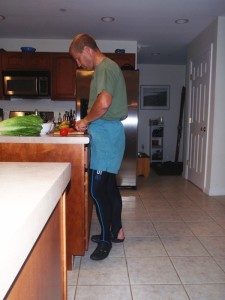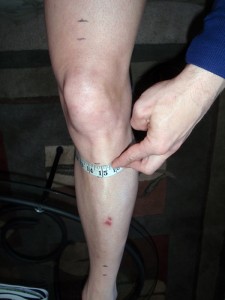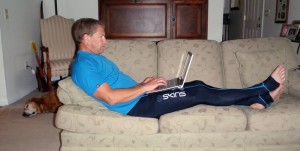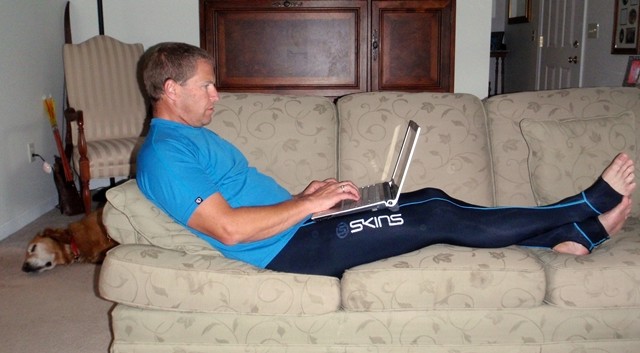(Editor’s note: While there are some empirical measurements in the following article, it is NOT intended to be a rigorous scientific study. Rather, the article is based on perceptions, with some measurements added to help us, and you, understand the effects. If anyone knows of any studies that have more useful information on the effects noted, please send us a link!)
Compression garments are one of the hottest fads on the market in the cycling world. Some of the biggest names in cycling wear them, and a variety of quality companies such as Skins, 2XU,Sugoi, and others make them. The basic concept is that compression increases blood flow from the extremities, making more oxygen available and increasing performance. But, there’s another use for them, and that’s recovery. If you take the same concept of increased blood flow and apply it to repairing damaged muscles, it just makes sense. And, Skins makes the SKINS Travel & Recovery Tight, which is designed specifically for recovery and airline travel. If you’re a big-name athlete traveling the world and getting paid the big bucks by sponsors, having a product that keeps you from getting swollen ankles at altitude makes a whole lot of sense; you want to be as fresh as possible when you land. But, is there any value in this for weekend warriors?

One problem that all of us part-time racers face is heavy, leaden legs when we arrive at a race venue. The typical situation is to get up in the morning, load the car, drive a couple of hours, check in, put our junk together, and if we’ve managed to be organized, get a half hour or so of warmup in before our 9:00 start time. More often, we’re struggling to just GET to the line on time…and then facing a hard, fast start from people who live closer by. Obviously, those people have the same problem when the race is in our backyard. Could the Skins tights work for PREcovery…that is, allow me arrive at the race venue with lighter, fresher legs, so that I can race better?
It happened that I had a perfect weekend planned to test them. On Saturday, I had the Tour of the Battenkill, a 62 mile race with tons of climbing; my absolute worst case scenario, since it’s also well over a 4 hour drive from my house. Even leaving the night before and staying closer by, it was still a lot of driving, no opportunity to warm up, and a hellish course. I’ve always been a slow starter, strong at the end of a long race, but I often can’t even stay IN the race long enough to fully warm up. Add the hills, which I’m too heavy for, and this was a race where I would expect to be coasting in at the back. Following the race, it’d be back in the car, drive home with sore legs, and race in an “A” training crit the next day. Translation: Sore and tired, get into a field with top local racers (including at least one professional) and see if I can manage to hang on. Historically, I haven’t finished that race with the field very often…and I’d never done it the day after a hard race.
So, how to tell if the Skins T&R tights really worked? Well, for starters, I wanted to see if I could get some actual numbers as to whether a long drive in a car at sea level really made a difference in leg edema. To do this, I marked off four points on my left leg with a magic marker (upper thigh, above knee, below knee, ankle), then took measurements at different times. I took 2 baseline measurements before and after work, then followed them with a measurement an hour after arriving at the Mount Snow Grand Summit hotel, about a 3 hour drive away, driving without the tights on. Then, I slept with the Skins on and took one more measurement the following morning an hour after getting up. The hour delay in those two sets of measurements was to make sure that there was no possibility that the measurements I was getting were short-term gains that would go away as soon as the tights were removed, and to make sure that any edema caused by the long drive wasn’t something that disappeared as soon as I started walking around. Here are the results, top of leg to bottom:

Baseline 1: 22.5/16.75/15.25/9.5
Baseline 2: 22.5/17/15.25/9.5
Post-drive: 22.75/17/15.5/9.75
Morning(tights on overnight): 22.5/16.75/15.125/9.25
Clearly, there’s a difference from baseline to post-drive; from baseline to morning, with a particularly large difference from post-drive to morning. A very rough calculation on my part, based on the differences in leg diameter, says that the extra volume in my legs between those two is around 65 cubic inches (31″ leg length, average circumference 17″, 1/8″ difference in radius). Water weighs .036 pounds/cubic inch, so…that means that each leg weighed roughly 2 1/3 pounds more after the drive without tights than it did after a night with the tights on! In a sport where we measure weights in fractions of an ounce, that’s a HUGE difference. Now, it would be reasonable to say “but that weight is simply water that moves elsewhere when it’s not in your legs, so you’re not really any lighter.” And, that’s likely true, although it would be hard to confirm that. However, on a bicycle, weight on my body is static weight; weight on my legs is moving weight, being lifted every time I pedal the bike. Saving a fraction of an ounce on the wheels is worth more than saving it on the bike frame; by the same token, weight lost in the legs is worth a lot more than weight lost on the body.
Just to confirm the effects of driving with or without the Skins recovery tights on, I also took measurements before and after a 2 hour drive with no athletic activity involved. The measurements were identical except for the below the knee measurement, which was actually 1/4 inch smaller than before the drive, confirming that the same compression action is at work while driving as when lying in bed. That would appear to make sense based on the fact that elite athletes wear them while flying, but it was worth checking to make sure.
So, that’s the “science,” as far as we’re able to take it. What was the perceived effect? Well…let’s just say that it was “one of those days” in getting ready for the race. The weather was very different from what had been forecast (much colder and windier, of course!), which caused a scramble to figure out the best clothing options; I had problems with one of my brakes; and the end result was, almost predictably, that I headed for the start line with no warmup. For the first couple of miles, it was nice and easy as the pack sorted itself out…and then the insanity started. And, for once, I was able to stay in the thick of things! At the first major climb, about 50 racers (of a field of 125) escaped off the front…that’s normal, as there’s always a group of college racers, people who train better, all of that fun stuff. But, as the rest of the pack started to splinter, I was able to stay solidly in the front section through the first major climbs. The story of the rest of the race will be written up in a different article, but the important part here is that I did better in the first half of the race than I have ever done before. I wasn’t better prepared, I hadn’t been training better…so it makes sense that moving lighter legs in a circle made me stronger and faster. Less work with each pedal stroke means lower heartrate, energy saved for the crushing efforts on hills, and just that little extra “oomph” when I needed it to stay with other riders at the top. I finished the race strong, taking long pulls at the front of our group; the early hills hadn’t entirely ripped me apart, as I’d expected they would. So, it definitely seemed that the “travel” portion of T&R works; the “PREcovery”, in my opinion, helped me to a much better finish than I could have imagined for that race.
But what about recovery? At the end of the race, I was experiencing cramping in my legs, particularly my right hamstring. That’s not a good sign, and with a 4 hour car ride immediately after the race, I knew that meant no putting my feet up on the dashboard to let my legs drain; that’s a guarantee of cramping. On went the Skins, into the car I got. And…NO cramping. I was able to ride with my feet up without pain or cramps, which certainly enhances recovery. Not only that, but after a race like that, my quads are tender; even touching them hurts. There really was no feeling of it during the ride home, or after…it was almost as if I hadn’t done a race. Knowing I had a race the next day, I kept the tights on during the evening, although I decided to sleep without them. In the morning, I put them back on when I got up, and kept them on for the next two hours until I got dressed for the race. I’ll admit, this race scares the daylights out of me; even though it’s pretty much flat, it tends to be windy, and some of the best racers of all categories in the state are in it. Can you say “out of my league”? And, from the gun, it was clear that it was going to hurt. I had to pay attention every second to make sure I didn’t lose the wheel of whoever was in front of me…that would be certain death. But, as the race progressed, it became clear that I had more “snap” in my legs than usual, and particularly for the day after a multi-hour race effort. It was hard work, but I was never in real danger of getting dropped. I finished strong, still having power and accelerating through the final stretch for a mid-pack finish…definitely my best showing ever for that race!
Obviously, I was pleased…but not done yet. Two days of rip-my-legs-off racing; I knew how I’d feel on Monday and Tuesday mornings. Sore and stiff, and hoping to be able to get my legs to loosen back up. Wrong. After the race, I put the T&R tights back on, and kept them on most of the afternoon. Luckily, they’re quite thin, so they fit under my business khakis without any problems, although the seams in the partial foot section can be uncomfortable in shoes; prepare to adjust them so that they don’t hit tender spots. During the afternoon, I noticed the same effect I’d noticed before; a gentle warm feeling on my legs that is more noticeable in some areas than others. Specifically, I noticed it in my quads and around my knees, which are probably my two greatest problem areas. I’ve got no science to back this up, but my gut feeling is that I was feeling increased blood flow, which was making me aware of the warmth since it wasn’t general but in defined areas (I have to say, though, that I didn’t specifically notice any particular feeling from the partial foot section; I’d like to test a pair of tights with one foot, the other cut off, to see if that part really makes a difference). Certainly, the following morning I was shocked and thrilled to find that I had NO pain when I got up. I’ve been abusing myself for enough years that I know that I always hurt and need some serious recovery after that much abuse. I doubt that I was at full strength, but I’d have felt comfortable going out for a very long ride…and that, I wouldn’t normally be able to do.

Over longer testing through the summer, the Skins tights continued to impress. I’ll admit, I wasn’t as religious about using them as I should have been; hot weather and tights are NOT fun companions. But, when I opted for comfort, I paid a price the next day…I could tell when I’d used the recovery tights after a hard ride and when I hadn’t. Believe me, when the time came to start preparing for the “crazy-style races,” I made sure to wear them! And it was at this point that I really was able to learn just how much difference they can make. I am NOT a runner; never have been, never will be a good one. With adventure races like the Wildman Biathlon, Sunday River’s Tough Mountain Challenge, and Stratton’s North Face Run To The Summit, though, I have no choice. Run or come in last; not a great choice. Run I did…and as always, it hurt. I’d finish a run nearly in tears from the pain in my quads, and know exactly what would happen the next day…people laughing at me as I nearly crawled down the stairs. Guess what? It never happened. Each run, I’d put the tights on; the next day, if not as good as new, I’d at least be able to walk normally. The ultimate test was when I decided to do my first 10k run; I’d never done more than 5k before. I, of course, picked a hot, humid day, and an extremely hilly course (one hill was constant for a full mile). And, I did it on pavement; trail running would have been smarter.
And, of course, within minutes of finishing, I knew how stupid it had been; I couldn’t even walk down the three stairs from the front door to the yard without wanting to cry. Normally, the pain of running lets up after the run, and doesn’t really kick in until after a night’s sleep. In this case, it just didn’t let up. On went the Skins, and instead of keeping them on for a few hours, I wore them overnight. And amazingly enough…NO significant pain the next day. Some stiffness, some soreness, definitely tired, but I could walk normally and even run. And after the longest, hardest run I’d ever done? Truly, I’m impressed.
Bottom line…at this point, I’m thoroughly convinced that 1) they work for travel before a race, which is a real benefit to weekend warriors, allowing them to perform at a higher level in a one-day race (if PREcovery makes it into the dictionary, I want it known that I invented the term!), and 2) they have an actual and significant effect on recovery, allowing for more strength and less pain the following day. There are few products I’ve tried over the years where the benefits seemed so obvious. Given that I’ve tried many other methods of recovery, including ice baths, lying on my back on the floor with my legs up against the wall, etc., to find something that is both easy AND effective is a huge benefit. Now, there are plenty of other compression products on the market (right now, Susan is testing some Sugoi Piston 200 compression recovery tights), and this article is not intended to determine the value of one product over another; however, to my knowledge, this is the only set of tights available that is designed only for recovery, and not for performance enhancement as well. As we test more compression gear, we’ll report on how those affect us. At this point, though, I can strongly recommend Skins Travel & Recovery tights to single day racers, stage racers, and people who just go out and push the limits, whether it be century rides, long hikes, half marathons, adventure races; wear them before and after the activity, and see how you feel!



I have just started wearing compression tights and although they don’t really seem to help with performance, i am seeing some benefits with regards to a reduction in recovery time between long runs. That might just be me getting fitter though lol
Great write-up, thanks! I’m travelling to NYC next week for the marathon and was wondering whether I should invest in these for the plane ride. I don’t believe in any significant effect during an effort, but “precovery”/travel and recovery might well be influenced. I’ll get me a pair now!
I’ll blame any sub-par marathon performance on you though 😉
Thanks for the write up. I am looking for performance tights to run and ride. Check out Opedix. I just contacted them to eliminate the Cho-Pats on both knees.
Note to Benjamin (too late though!!!)
I also ran the NYC Marathon on Sunday. Sunday night I fell asleep after the “celebration.” However, Monday I wore my Zoot recovery tights all day (went to the Finisher’s Tent and all through NYC. I feel GREAT. By the way, I wore them on the flight from California to New York and my legs felt wonderful.
Hope your run was as dramatic as mine!!!
Styephen-
We’ve actually been testing the Opedix; there’ll be an upcoming review of those and some CX-W tights. Overall, we’ve found both useful, with the Opedix being better for skiing, the CW-X better for cycling (the stronger support straps of the Opedix not being designed for the leg angle used in cycling, they cause chafing on the tendons behind the knee). Congratulations on your marathon!
David